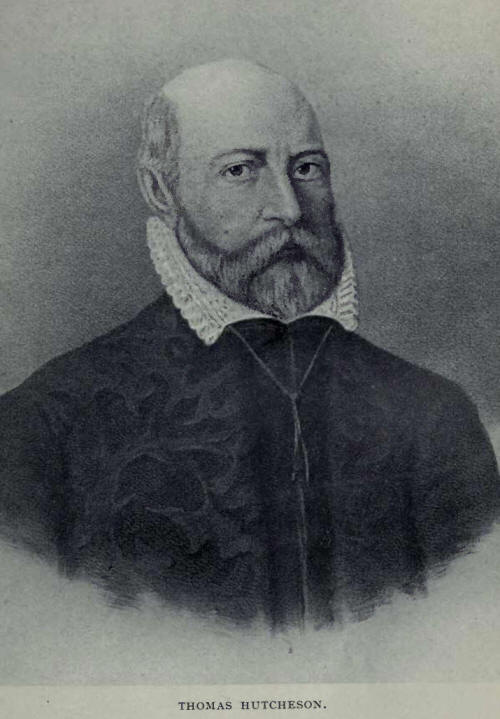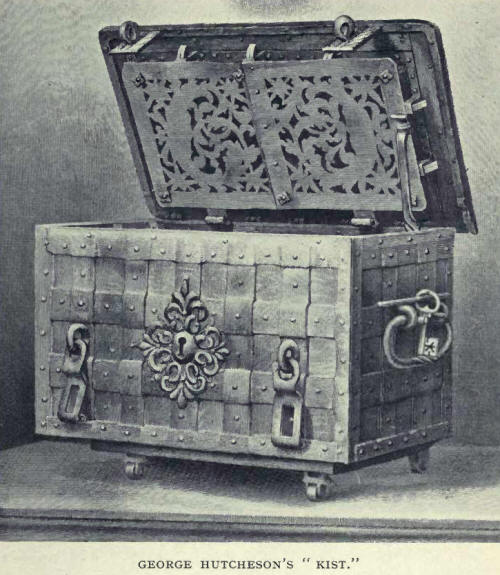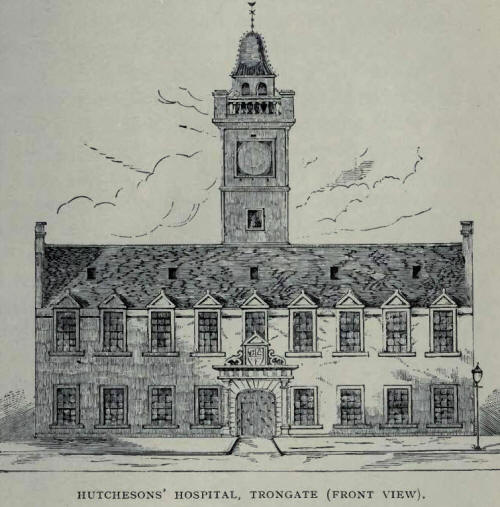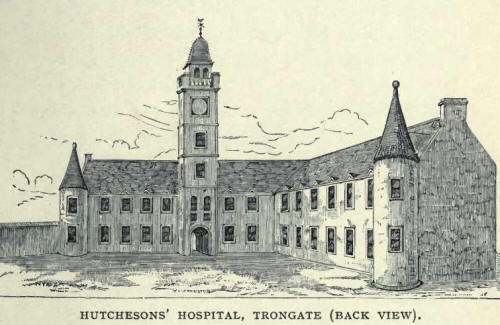|
WHILE political affairs were in this
critical posture throughout the country there died a man who stands
conspicuous as a type of the better class of Glasgow citizen from
that time till now. Sir Walter Scott has stereotyped the Glasgow
shopkeeper magnates of a century later in his picture, of the
worthy, pawky, generous, and warm-hearted Bailie Nicol Jarvie. A
portrait, equally true and interesting, of the professional class in
bygone Glasgow, is furnished by the career and character of George
Hutcheson, the original founder of Hutchesons' Hospital.
All the known facts regarding the
Hutcheson family, and in particular regarding the two brothers,
George and Thomas, who founded the most important charitable
institution in the city, have been brought together in the history
of the hospital and school by their collateral descendant, Dr.
William H. Hill.
In the latter part of the fifteenth
century the Hutchisons or Hutchesons appear in the annals of the
city as substantial people, making gifts to the Church, and holding
office in the College; and in the next century, the days of James V.
and Mary Queen of Scots, their sons are found enrolled as students
of the University. They were rentallers, or tenants of the lands of
Gairbraid, a mile to the west of the city, and when, after the
Reformation, the old annual rents were converted into feu-duties,
they became the owners of that property. Thomas Hutcheson, the
younger son of John Hutcheson of Gairbraid, acquired from the
archbishop in 1579 the two-merk land of Lambhill, and from the Lord
Feu-farmer, Walter Stewart of Blantyre, in 1587, the merkland of
Hutchesontoun at Nether Carmyle. He had also other properties in
Provanside, Gallowgate, Drygate, and elsewhere. He had at the same
time a house on the north side of Trongate, apparently adjoining the
tolbooth, which was afterwards the dwelling-house and place of
business of his son, the notary, George.
Thomas Hutcheson had two sons, George
the eldest and Thomas the youngest of his family, with three
daughters coming between; he died about the year 1594. His son
George was then about forty years of age. The mother of the latter
was Helen, sister of Sir William Herbertson, a Roman priest, and
probably a cousin of the Hutchesons.
By the time he succeeded to his father's
considerable estates, George Hutcheson was evidently in a
substantial position as a writer or procurator and notary in the
city. In 1587 he appears as the notary acting in the infeftment of
Walter Stewart, afterwards first Lord Blantyre, as Commendator, or
lay possessor, of the barony of Glasgow. That he was a man of strong
passions is evident from the next item of his career in the annals
of the city. In the records of Glasgow kirk-session in 1588 it is
set forth that, having become the father of a "demesell bairn" by
Elizabeth or Elspeth Craig, and having declared his willingness to
marry the lady, he is ordered to make his public repentance on the
first Sunday forenoon, and to marry "the said Elizabeth" within one
month. For due compliance with these injunctions his father became
his security to the amount of forty pounds. Elspeth Craig is
believed to have been a sister or daughter of John Craig, writer and
notary public in Glasgow, and the union thus irregularly begun
lasted for the long period of forty-four years; but there is no
evidence that any other children were born of the marriage. Outside
the marriage tie, however, the redoubtable notary had another
daughter, Janet, who lived and ended her days in Holland, and it is
tragic to find that she came to be dependent on the public bounty of
the city, of which her father was so great a benefactor. In 1679 the
Burgh Treasurer was ordered "to pay to John Craig ten dukadounes,
quhilk he is to send to Holland to Janet Hutcheson, naturall
daughter to umquhile George Hutchesone, for her supply," and the
payment was to be repeated yearly during her life. [See also Burgh
Records, 24th July, 1680.] The gratuity was not long required. In
1684 the same records contain an order to the Dean of Guild to pay
X30 Scots to Jean Main, "for helpin to pay the funerall of Janet
Hutchesoune, ane pensioner of the toune, who deceist in Holland."
The Presbytery records also show that in
16oi George Hutcheson and a certain Ard Eglinton had drawn their "whingers"
and engaged in a brawl in the High Kirk. And as late as 1633 an
action of lawburrows was taken out against Hutcheson under a penalty
of 400 merks by his neighbour at Partick, John Ross of Stobcross, to
assure that his wife, bairns, men, tenants, and servants should be
"harmless and skaithless " from Hutcheson's interference.
But these somewhat questionable episodes
in his private career do not seem to have affected in any way George
Hutcheson's repute as a citizen and man of business. In 1589, in the
docquet to a sasine in favour of Mrs. Marion Luke of Claythorn, he
excuses himself for not writing the whole docquet himself, as he
should have done, by the statement that he was much engaged with
other business. Part of that business was the feuing of the lands of
the Barony and Regality of Glasgow, on behalf of the Commendator of
Blantyre, to the old yearly tenants of the archbishops, and this
work, according to Sir Robert Douglas of Glenbervie, "he performed
to good purpose." He also in 1601 acted as procurator for the
Commendator in presenting Mr. David Wemyss, the worthy minister of
the city,

to the vacant parsonage of Glasgow.
Probably a good deal of the initiative for these far-seeing acts lay
with George Hutcheson himself, and to that far-sightedness the city
no doubt owed much of its subsequent happiness and prosperity.
Hutcheson appears also to have acted in
many matters as the Glasgow law agent both for Ludovic, Duke of
Lennox, and for the archbishop. A charter by the duke endowing a
bursary at the College in 1604 was written and witnessed by him, and
his name also appears in a charter by which the archbishop, three
years later, granted the College certain additional bolls of meal
from the mill at Partick. It is true that, when he applied for the
clerkship of the Dean of Guild Court in 1605 he was placed only
second in a leet of four, the appointment going to Archibald Heygait,
the Town Clerk and Clerk of the Burgh Court. But Heygait, as has
been already seen, had special influences at work in his favour at
that time. Hutcheson, all the same, was entrusted with important
business by the Town Council. When the bailies of Glasgow and
Dunbarton brought an action against a Dutchman, John Lubbart, master
and owner of an Amsterdam ship, for disposing of his cargo of timber
privately in Glasgow before offering it to the burgh authorities,
George Hutcheson was the agent employed by the city.
From entries in the munimenta it is
evident that he also acted as agent for the University. In 1606 and
1608 that body was "pursuing" a certain John Stewart. In the former
year he received for advising the process at Edinburgh, and 11s.
"for ane pynt of wyne quhen the proces was resavit"; and in the
latter year he was paid £6 for his trouble in pursuit of the same
John Stewart before the Commissary Court at Hamilton. Again, ten
years later, he received £13 6s. 8d., with £3 6s. 8d. for drink
money to his men, for carrying out the sasine of the kirks of
Kilbride and Renfrew; and in 1628 and 1629 he acted for both parties
in charters of confirmation, novodamus, and ratification of teinds
and immunities granted by Archbishop Law to the College.
That the favours were not all on one
side is shown by the fact that in 1632, when the Principal of the
University was engaged in extending the buildings of the College,
Hutcheson appears among the subscribers as the contributor of 100
merks. A transaction which to
our eyes at the present day appears somewhat questionable, is that
by which the Glasgow notary became a Judge-Depute in the Commissary
Courts of Glasgow and Hamilton. The Commissary Judge appointed by
Archbishop Law was John Boyle of Kelburne, ancestor of the Earls of
Glasgow, "a gentleman of so great legal knowledge and integrity as
to have had the honour of being appointed to revise and improve the
laws of Scotland." Kelburne did not himself act, but appointed a
deputy. That deputy was George Hutcheson, and for the appointment
Hutcheson paid Kelburne £900 Scots per annum. The commission,
granted with consent of the archbishop, bears that Kelburne was too
much distracted by the king's business and his own to perform his
duties in the Commissary Court, while Hutcheson was well known to be
in every way qualified. The latter was therefore empowered to
pronounce and issue decreets, sentences, and interlocutors, confirm
testaments, and examine witnesses. The document has its counterpart
at the present day in the commission granted to a
sheriff-substitute. There are, however, two important differences,
significant of the contrast between the ideas of administering
justice at that time and now. The sheriff-substitute of to-day does
not pay for his judgeship, nor does the sheriff-principal oblige
himself to abide by his substitute's decisions "without any
revocation or gainsaying whatsoever."
While holding probably the foremost
position as a notary and procurator in the city, George Hutcheson
also carried on a

large business as a banker and
moneylender. In this business Scotsmen seem to have given the lead
to England, where the London goldsmiths only began to receive money
and lend it out at interest and to honour their customers' cheques
in 1645. [Annals of Commerce, ii. 427.] In Scotland George Heriot
had been lending money to the king and queen on the security of the
royal jewels as early at least as 1599. [Memoir of George Heriot, p.
6.] His business, however, was mostly confined to Edinburgh and the
East of Scotland. In Glasgow and the West the Union of the Crowns in
1603 produced many developments. Industry and trade began to grow,
and the city was able to build itself a stately new tolbooth. The
colonizing project suggested to King James by Sir William Alexander,
Earl of Stirling, began to waken golden dreams in the minds of the
people. And, even more alluring, the possibilities opened to
Scotsmen of winning appointments and titles at the English court
made an irresistible appeal. For all these enterprises money was
required. Among owners of heritable property the usual proceeding
was to borrow money on the security of a wadset or mortgage over
their estates. The proceeding, however, was cumbrous and expensive.
For a merchant, also, whose possessions were cargoes at sea and
widely scattered book debts, it was not available. In these
circumstances George Hutcheson's capital came into great request.
His plan was to lend money on simple bonds by the borrower, and the
security of two or more persons of substance. For the drawing of
these early promissory notes he allowed his clerk to charge no more
than three halfpence sterling, and his own interest was seldom more
than eight per cent. He must, therefore, be regarded as the earliest
banker in Glasgow, anticipating the foundation of the Bank of
Scotland by some three quarters of a century. Lists of these bonds
still in existence, which were handed to his three sisters and his
sister-in-law after his brother's death, show the sums in which lie
dealt to have ranged from a hundred merks to five thousand, while
among his borrowers were Sir James Hamilton of Fingalton, Cuninghame
of Carlung, the lairds of Gadgirth and Achinemes, Sir Robert
Montgomerie, Lord Montgomerie, and the magistrates and town council
of Glasgow'itself. [ History Hutchesons' Hospital, p. 27.] The
last-named seem to have paid the interest on their loan on at least
one occasion by crediting "the said George" with a portion of the
stent or rates payable by him. [Burgh Records, 5th June, 1637, 14th
Jan. 1638.] The notary had his
counting-house or chambers on the ground floor of his house next the
tolbooth, up the gable of 40 which he paid the Corporation two
hundred merks for the right to train his chimney vents. In his
business room stood "a long fixed oak table, with his papers at one
end, and at the other a large silver drinking tankard, replenished
with wine or ale, for the refreshment, without ceremony or
invitation, of his clients." His bonds, ready money, and charters
were kept in his bedroom in a Dutch-built, spring-locked chest,
woven of strips of iron, now preserved in the Faculty of
Procurators' Library. He had a stable behind his house, a garden at
hand, and another property on the south side of Trongate, opposite
the present Hutcheson Street. Also he built for himself a country
house at the mouth of the Kelvin in Partick, on lands which had
belonged to the archbishop. This house latterly, when a ruin, was
popularly known as "the Bishop's Castle." It is so named by Chalmers
in his Caledonia (iii. 629), and the ancient country seat of the
archbishops very probably occupied the same site. But Hutcheson's
original contract with a Kilwinning mason for the building still
exists. It shows that the standard of measurement was to be "the
said Georges awin fute." The price was five hundred and thirty merks,
including a hundred merks "in satisfaction of all morning and
efternoonis drinks, disjoynes, Sondays meitt, drink at onlaying of
lyntalls, or onie uther thing that can be cravit fra ye said

George, in ony sorte." The house had
large walled gardens and considerable lands belonging to it, and,
with its beautiful situation, spoke eloquently for the good taste of
its owners. [Hamilton of Wishaw's Description of Lanarkshire, p. 29;
Hugh Macdonald's Rambles Round Glasgow; Hist. Hutchesons' Hospital,
p. 29.] George Hutcheson's
other possessions included the lands of Barrowfield to the east of
Glasgow, on which Bridgeton is now built; Gartsherrie, Auchengray,
and Caldercruix in the Monk-lands; Yoker and Blawarthill to the
west, which he acquired for 13,000 merks ; Deanfield in Renfrew;
Grainges in the parish of Dunlop in Ayrshire; Over and Nether
Gairbraid and part of Garioch in what is now Maryhill; Ramshorn and
Meadowflat, including what is now George Square and the site of the
City Chambers in the city itself; and the paternal estate of
Lamb-hill to the north of modern Glasgow. He had also eighty-seven
tenants paying him rent in kind—straw, hens, capons, herrings, and
shop rents, while half the landowners in the West of Scotland, from
the Earl of Wigton to Colquhoun of Luss were paying him money
interest and annual rents. [Hist. Hutchesons' Hospital, p. 33.]
Such was George Hutcheson, probably the
most capable and prosperous professional man in the Glasgow of his
time. His character, however, is further revealed in the institution
which so nobly perpetuates his name among the citizens of Glasgow at
the present day. He died on the day after Christmas in 1639, and
according to his own desire was buried in the tomb of his family on
the east side of the Cathedral. In his last will and testament,
which he declares to have been written while he was "somquhat seik
in bodie, bot of perfyte mind and memorie," he left several kindly
legacies to servants and relatives, fulfilled his wife's desire that
he should give his sister's daughter fifty merks yearly during her
life, and appointed as his heir and executor his brother Thomas
Hutcheson, whom he exhorted "to follow sage advyce of counsell of
friends in his adoes, because it hes not pleised God to give him sic
knowledge as his place and affers now requires."
This brother, some thirty-five years
younger than himself, George Hutcheson had reared and educated at
the University. At first he was intended for the ministry, but took
to law, and by his brother's influence was appointed Registrar of
Sasines to the city. He was a graduate, a man of culture, and on
terms of friendship with the professors of the College, subscribing
£1000 to enlarge the library building and 2000 merks to found a
bursary as an endowment for the librarian. Between the two brothers
a very tender regard appears to have existed, and after the death of
George Hutcheson his wishes were most loyally carried out by the
younger man. About that time
two very notable benevolent institutions had been founded in
Scotland. George Heriot, the Edinburgh goldsmith and financier, who
figures as "Jingling Geordie" in Sir Walter Scott's Fortunes of
Nigel, and who died in 1624, "mortified" or bequeathed a large sum
of money for the foundation of the "hospital" which still
commemorates his name in Edinburgh. The hospital itself was not
built till 1759. Nine years after him, in 1633, died John Cowane, a
wealthy burgess of Stirling, who in similar fashion "mortified" a
considerable sum for the founding of a hospital or almshouse. His
hospital, which is still one of the great benevolent institutions of
Stirling, was built in 1639, the year in which George Hutcheson
died. These beneficent bequests may or may not have furnished a
suggestion to the wealthy Glasgow notary, but they show that the
idea was in the air in his time. Whether he was inspired by a
movement fashionable at that day, or was simply following the
example of earlier founders of similar institutions in Glasgow
itself, like Bishop Muirhead, who founded St. Nicholas Hospital in
1474, George Hutcheson ten days before his death bequeathed a
tenement and twenty thousand merks, or £1111 2s. 2d. sterling, to
found an almshouse for aged, decrepit, and destitute

men of good character. The foundation,
he calculated, would support eleven beneficiaries, who were to be
lodged in the Hospital, provided with fuel and a yearly gown, and
receive for their maintenance four shillings Scots, or fourpence
sterling per day. His brother and heir, Thomas Hutcheson, not only
ratified the bequest, but added 10,500 merks (£583 6s. 8d. sterling)
and several other sums to the endowment, and himself laid the
foundation stone of the hospital on the north side of Trongate in
1641. In the same month of March Thomas " mortified " an adjoining
tenement in Trongate and 20,200 merks for the lodging and education
of twelve orphan boys, sons of burgesses of the town.
The amount bequeathed by the two
brothers for hospital and school has been estimated to amount
altogether to £4017 15s. 6d. [Hist. Hutchesons' Hospital, p. 65.] By
Thomas Hutcheson's direction the funds were invested in "the
cheappist and best haldin arrabill lands they can gett to buy
therewith, near to the said Burgh." By later benefactors several
smaller sums have been added, and today the property of Hutchesons'
Trust is valued at considerably more than £400,000 sterling.
Hutcheson Street, off Trongate, occupies the site of the original
hospital and its garden acre behind; the statues of George and
Thomas Hutcheson decorate the front of the later hospital building
opposite the head of the street ; and on the south side of the river
a considerable district, the land in which the greater part of the
funds of the hospital was ultimately invested, is known as
Hutchesontown. |

